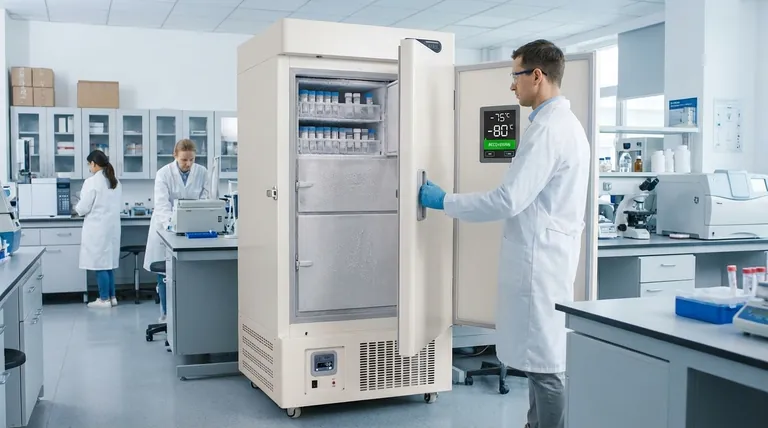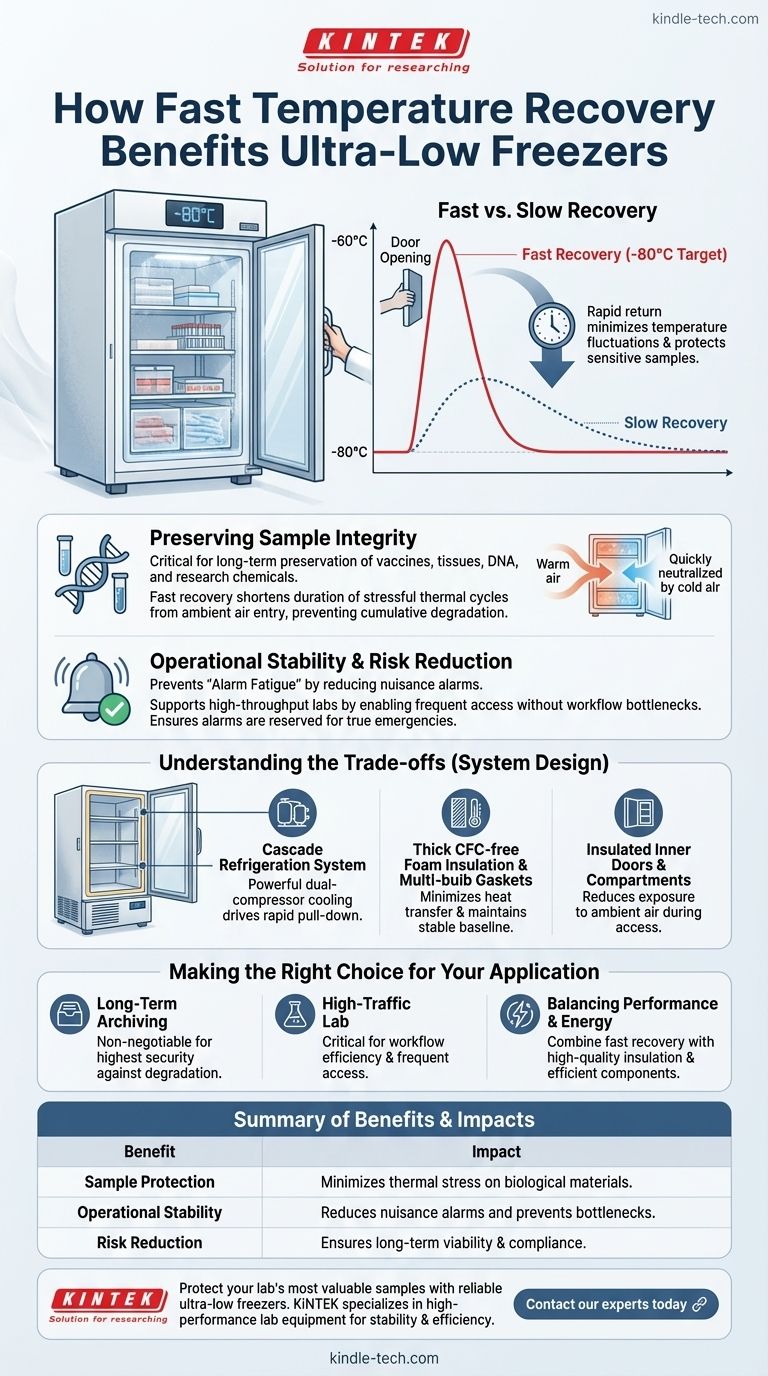In an ultra-low temperature (ULT) freezer, fast temperature recovery is a critical performance feature. After a door opening introduces warm air, a rapid return to the setpoint (e.g., -80°C) is essential for minimizing temperature fluctuations that can damage sensitive biological samples. This feature directly protects the integrity of stored materials and reduces the frequency of nuisance alarms in a busy lab environment.
The core purpose of a ULT freezer is to create a stable, unchanging environment. Fast temperature recovery is not a luxury but a fundamental mechanism for counteracting the single biggest source of instability: human access. It directly translates to lower risk and higher confidence in the viability of your stored samples.

The Core Mission: Preserving Sample Integrity
The primary function of a ULT freezer is the long-term preservation of invaluable biological materials, from vaccines and tissues to DNA and research chemicals. Temperature stability is the most critical factor in achieving this mission.
What Happens When a Freezer Door Opens?
Every time a freezer door is opened, warmer, more humid ambient air rushes in. This immediately begins to warm the air and surfaces inside the chamber, causing a temperature spike.
Sensitive biological and chemical samples can be degraded by these repeated thermal cycles. The faster the freezer can remove this heat and return to its ultra-low setpoint, the shorter the duration of this stressful temperature excursion.
The Cumulative Impact of Fluctuations
A single, brief door opening may seem insignificant. However, in a working laboratory, freezers are accessed multiple times per day.
The cumulative effect of these small temperature spikes can degrade samples over weeks and months. Fast recovery ensures that each access event has the absolute minimum impact, preserving sample viability over the long term.
Operational Stability and Reducing Risk
Beyond sample integrity, fast recovery plays a key role in the smooth and safe operation of a laboratory. A freezer that struggles to maintain its temperature creates unnecessary work and risk.
Preventing "Alarm Fatigue"
ULT freezers are equipped with alarms to alert staff of temperature deviations. A freezer with slow recovery may trigger its alarm after every routine door opening.
This leads to "alarm fatigue," where staff become desensitized to the alerts and may not respond quickly to a genuine system failure. Fast recovery ensures that alarms are reserved for true emergencies.
Supporting High-Throughput Environments
In busy clinical or research labs, frequent sample access is a necessity. Slow recovery times would create bottlenecks, forcing staff to wait between door openings to allow the temperature to stabilize.
Rapid recovery enables efficient workflow, allowing users to access samples as needed without compromising the entire stored inventory.
Understanding the Trade-offs
Fast temperature recovery is a function of the entire freezer system, not just one component. Evaluating it requires looking at the complete design.
The Role of the Refrigeration System
Modern ULT freezers often use powerful cascade refrigeration systems. These dual-compressor systems are engineered for high-performance cooling and are the primary driver of rapid temperature pull-down and recovery.
The Importance of Insulation and Gaskets
Superior recovery speed is meaningless if the freezer cannot hold its temperature. High-quality, thick CFC-free foam insulation minimizes heat transfer from the outside.
Furthermore, multi-bulb gaskets around the door create a tight seal, preventing cold air from leaking out and warm air from seeping in. This provides a stable baseline from which the refrigeration system can work more efficiently.
Internal Doors and Compartments
Many ULT freezers feature a set of insulated inner doors that seal off individual compartments. This is a crucial design element.
When accessing one shelf, only that small section is exposed to ambient air. This dramatically reduces the overall temperature disruption and lessens the recovery burden on the compressor system.
Making the Right Choice for Your Application
Prioritizing fast temperature recovery depends on your lab's specific needs and workflow.
- If your primary focus is long-term archiving of irreplaceable samples: Fast recovery is a non-negotiable feature that provides the highest level of security against degradation.
- If you operate a high-traffic lab with frequent access: This feature is critical for maintaining both sample integrity and operational efficiency, preventing workflow bottlenecks.
- If you are balancing performance with energy goals: Look for a freezer that combines fast recovery with high-quality insulation, advanced gaskets, and efficient compressors to achieve stability without excessive power consumption.
Ultimately, choosing a freezer with fast temperature recovery is a direct investment in the quality and reliability of your work.
Summary Table:
| Benefit | Impact |
|---|---|
| Sample Protection | Minimizes thermal stress on biological materials like vaccines, DNA, and tissues. |
| Operational Stability | Reduces nuisance alarms and prevents workflow bottlenecks in busy labs. |
| Risk Reduction | Ensures long-term sample viability and compliance with storage protocols. |
Protect your lab's most valuable samples with reliable ultra-low freezers. At KINTEK, we specialize in high-performance lab equipment designed for stability and efficiency. Our ULT freezers feature rapid temperature recovery, robust insulation, and energy-efficient systems to safeguard your research and clinical materials. Contact our experts today to find the perfect freezer for your laboratory's needs!
Visual Guide

Related Products
- 808L Precision Laboratory Vertical Ultra Low Temperature Freezer
- 28L Compact Upright Ultra Low Temperature Freezer for Laboratory
- 108L Vertical Ultra Low Temperature ULT Freezer
- 508L Advanced Vertical Ultra Low Temperature Freezer for Critical Laboratory Storage
- 708L Ultra Low Temperature Freezer High Performance Laboratory Freezer
People Also Ask
- What is an ultra-low temperature freezer? Protect Your Most Valuable Biological Samples
- What are the common designs of ultra-low temperature freezers? Upright vs. Chest Models for Your Lab
- What are ultra low temperature freezers used for? Preserving Critical Biological Samples for Decades
- What are the key construction features of ultra low temperature freezers? Essential Design for Protecting Critical Samples
- What makes Ultra-Low Temperature freezers energy efficient? Key Design & Operational Strategies



















